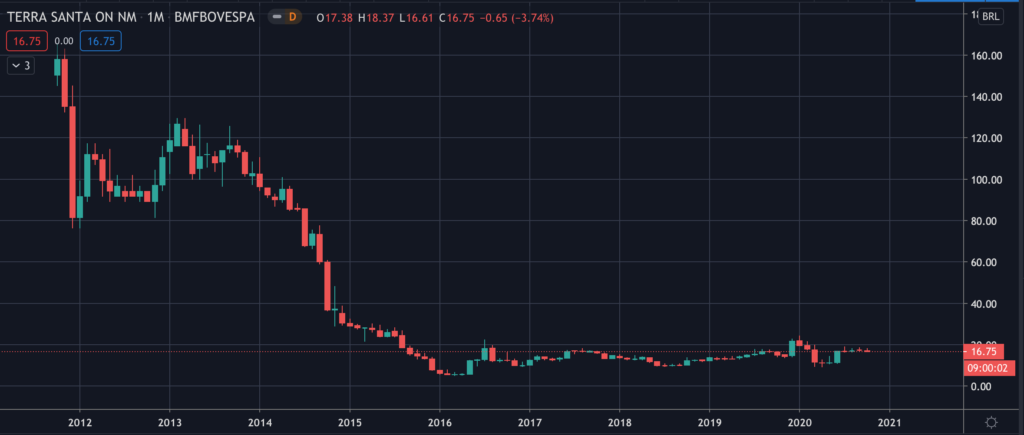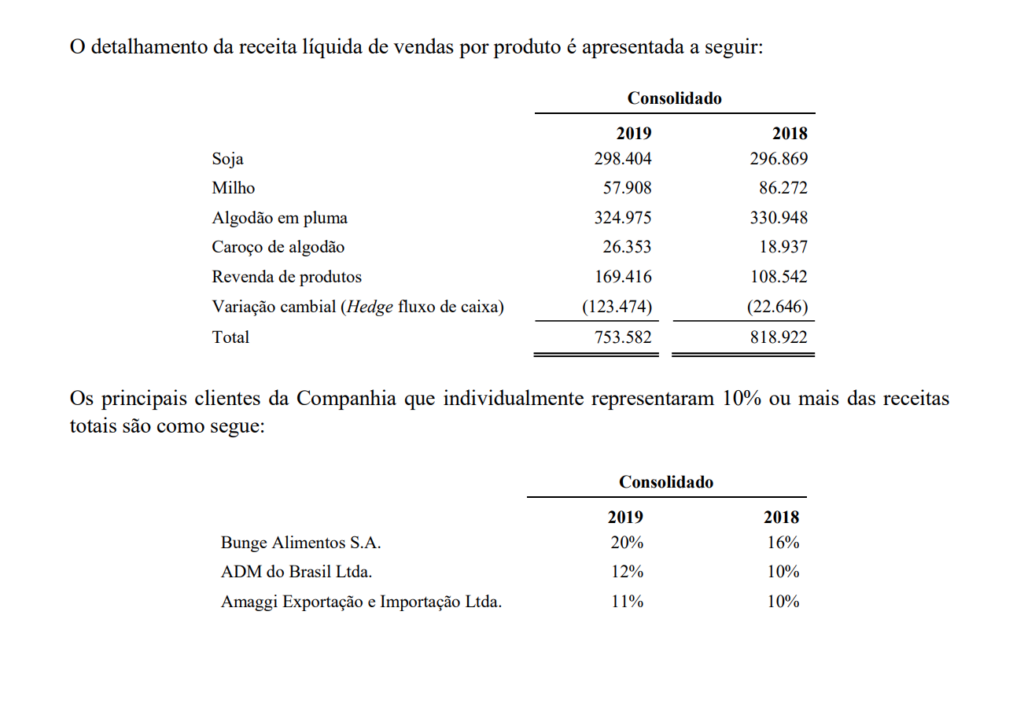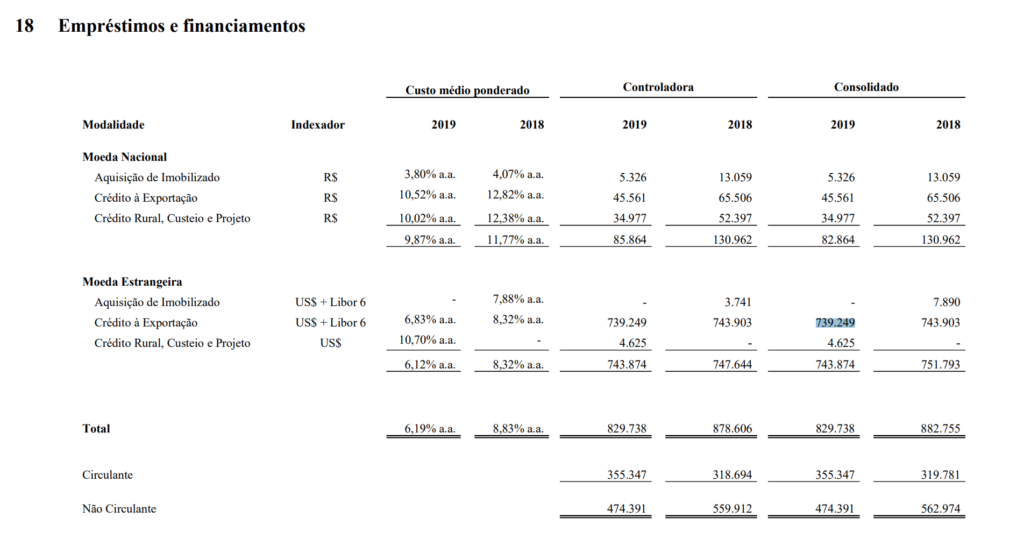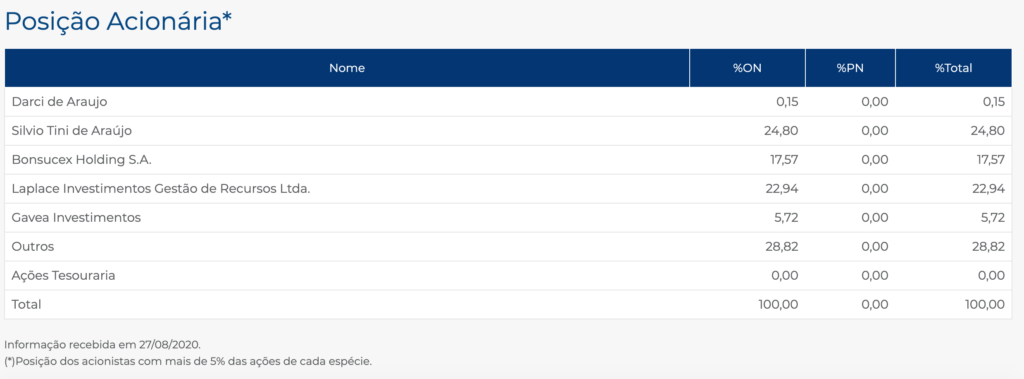Common Stock: Terra Santa Agro (TESA3)
Current Market Price: R$ 16.75
Market Capitalization: R$ 362.7 million
*All values in this article are expressed in Brazilian Reais (BRL) unless otherwise noted.
**The bulk of this analysis is based on the company’s most recent audited financial report, which can be found by following this link.

Terra Santa Stock – Summary of the Company
Terra Santa is a Brazilian agriculture company focused on the production of soybeans, corn, and cotton. They operate 7 production units, all located in the state of Mato Grosso. The company manages around 143,000 hectares of land. Terra Santa was founded in 2006 and is headquartered in the state of Mato Grosso, Brazil.
Revenue and Cost Analysis
Terra Santa had total revenue of R$ 961.2 million in 2019, a significant decrease from revenue of R$ 1.1 billion in 2018. The company was profitable in both 2017 and 2018, however they had a significant net loss of R$ 134.7 million in 2019. The deterioration in the company’s performance is due to lower top line sales and lower gross margins.
In 2019 cotton was the company’s largest crop in terms of revenue followed closely by soy. Corn was a much smaller, but relevant percentage of revenue. Terra Santa has three key clients that account for over 10% of total revenue, Bunge, ADM, and Amaggi.

Balance Sheet Analysis
Terra Santa has a weak balance sheet. They do have a solid base of long term assets, however their liquidity position is weak and liability levels are high, including debt.
It is worth noting that the company hedges its commodity exposure via futures contracts. Investors should analyze the company’s hedge book in detail before investing.
Terra Santa – Debt Analysis
Terra Santa has a significant amount of debt outstanding. As of year-end 2019 the company has R$ 829.7 million in total debt outstanding, R$ 355.3 million of which is classified as current. A significant amount of their debt is denominated in US dollars, exposing the company to the negative effects of a depreciating Brazilian Real. R$ 743.8 million of Terra Santa’s debt is denominated in US dollars.

Terra Santa Stock – Share Dynamics and Capital Structure
As of year-end 2019 Terra Santa has 21.6 million common shares outstanding. Several insiders and three institutional investors own around 71% of the company, with the remaining 29% being held by smaller investors with less than a 5% ownership position.

Terra Santa Stock – Dividends
The company does not currently pay a dividend.
Terra Santa Stock – 3 Metrics to Consider
Debt to Equity Ratio
Total Liabilities/Total Share Holder Equity
R$ 1.5 billion / R$ 943 million = 1.6
A debt to equity ratio of 1.6 indicates that Terra Santa has a leveraged balance sheet and relies heavily on debt financing.
Working Capital Ratio
Current Assets/Current Liabilities
R$ 728.6 / R$ 786.8 = .93
A working capital ratio of .93 indicates a weak liquidity position. Investors should monitor Terra Santa’s liquidity position carefully for any deterioration.
Price to Book Ratio
Current Share Price/Book Value per Share.
R$ 16.75 / R$ 43.50 = .38
Terra Santa has a book value per share of R$43.50. At the current market price this implies a price to book ratio of .38, meaning the company’s stock currently trades at a significant discount to the book value of the company.
Brazilian Agriculture Market – Economic Factors and Competitive Landscape
Brazil is an agricultural powerhouse, it ranks 5th in the world in terms of arable land. Agriculture is a large and important industry for the Brazilian economy. Brazil is the world’s largest producer of oranges, sugarcane, and coffee. They also compete globally in the production of soy, meat, and corn. Brazils’ diverse geography allows it to produce a wide variety of crops.
Global agricultural is a highly competitive market subject to large swings in global commodity prices. Brazilian agricultural companies will have to compete fiercely on a global stage for exports. However, given the scale of the industry in Brazil, I believe it is reasonable to assume that there are many well run, investable agriculture companies in Brazil.
Terra Santa Stock – Summary and Conclusions
Terra Santa is a decent company. They own a sizeable land portfolio and have been able to do so profitably in the past. However their financial position is weak and they are over exposed to a depreciating Brazilian Real via their US dollar denominated debt.
I don’t like to invest in Brazilian companies exposed to the USD carry trade. I am also concerned about Terra Santa’s deteriorating revenue and operating results. For those reasons I am not willing to invest in Terra Santa stock. If I do decide I want exposure to the Brazilian agriculture market, other companies, such as Brasil Agro, rank higher on my watch list.
Disclaimer
This is not investment advice. Nothing in this analysis should be construed as a recommendation to buy, sell, or otherwise take action related to the security discussed. If I own a position in the security discussed, I will clearly state it.
This is not intended to be a comprehensive analysis and you should not make an investment decision based solely on the information in this analysis. I hope this serves as a useful starting point for a more comprehensive analysis, and hopefully draws attention to aspects of the company that were overlooked or merit further investigation. This is by no means intended to be a complete analysis. Again, this is not investment advice, do your own research.